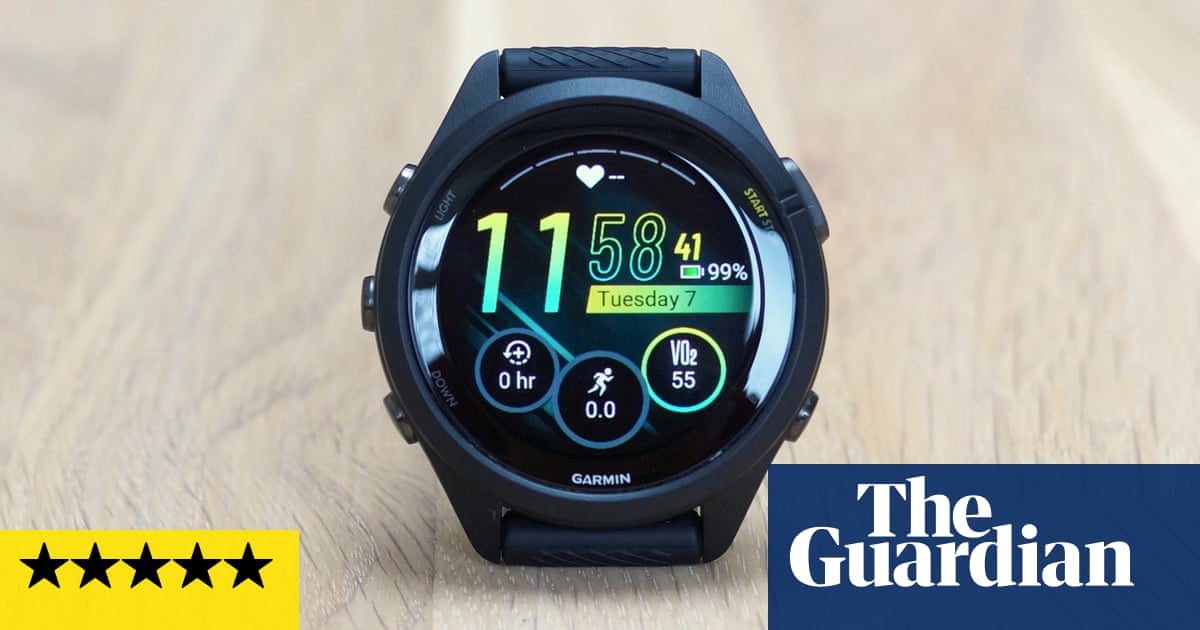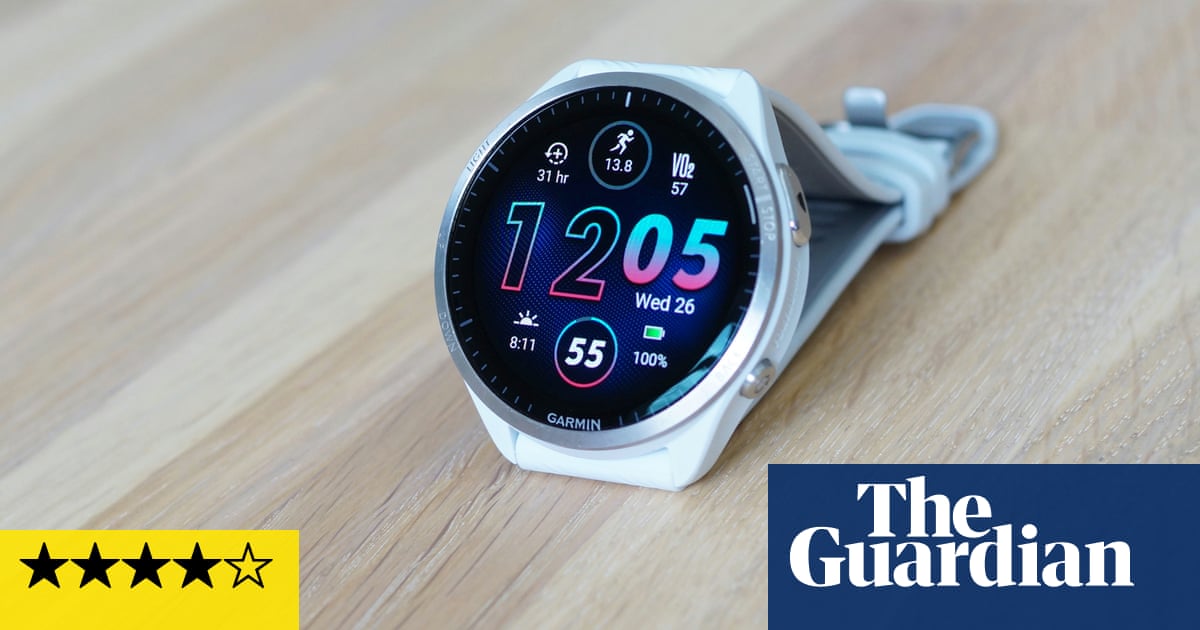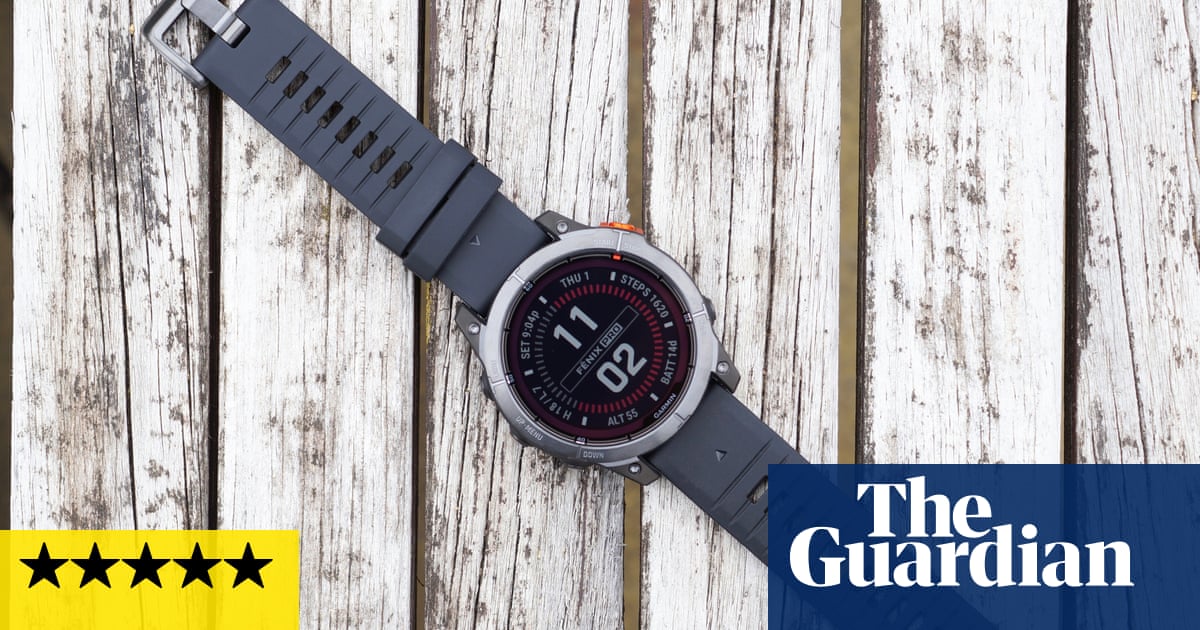
The Forerunner 245 is Garmin’s excellent performance running watch and sets a new benchmark against which the competition should be measured.
Two versions are available: one which can download music and one which cannot at a recommended retail price of £299.99 or £249.99 respectively. It came out in April 2019 to replace the popular Forerunner 235.
The Forerunner 245 resembles a round digital watch and is just 42.3mm wide, 12.2mm thick and 38.5g in weight, which by sports watch standards is tiny, comparing favourably with the likes of Samsung’s Galaxy Watch Active 2 and the Apple Watch Series 5. It takes standard universal 20mm watch bands and comes with an excellent traditional silicone strap that fits wrists between 127mm and 204mm in circumference: in other words most wrists.
The colour transflective LCD display – which is not a touchscreen – can be seen in direct sunlight without the need for a backlight, although there is one for the night. The display is clear and easily readable at a glance, but is pretty basic compared with the flashy OLED screens on smartwatches. Think of it more like an advanced colour digital watch and you will get the idea.
There are quite a few watch faces to choose from, including digital and analogue options, plus many more available from third parties via Garmin’s Connect IQ store.
The up, down and back buttons take you around the interface. The start/stop button doubles as a select button and the light button powers the watch on and accesses quick settings. Press and hold the down button to access music controls or the up button to quickly jump to the full settings menus.
From the watch face you can also access a long list of customisable widgets using the up and down buttons, including smartphone notifications, calendar, the weather, health stats, stress levels, your heart rate, previous runs and many others.
Specifications
Screen: 1.2in transflective MIP (240x240 pixels)
Case size: 42.3mm
Case thickness: 12.2mm
Band size: standard 20mm quick release
Weight: 38.5g
Storage: 3.5GB/500 songs
Water resistance: 50 metres (5ATM)
Sensors: GPS/Glonass/Galileo, compass, accelerometer, heart rate, pulse Ox
Connectivity: Bluetooth 4.2, ANT+, wifi (Music only)
Charging and syncing
The Forerunner 245 fully charges in two hours via a short snap-in USB cable that plugs into the back of the watch and can connect to Garmin’s desktop Express software on Windows or Mac.
The watch connects to your Android or iPhone via Bluetooth and the Garmin Connect app, which handles syncing data, updates, smart notifications and other bits. The separate Garmin Connect IQ app handles installing apps, including watch faces, widgets and music services.
The Forerunner 245 Music also has wifi for syncing your activities straight to the cloud, downloading music and software updates.
The Garmin Connect app is extremely comprehensive, able to display an almost bewildering amount of information, with analysis often reserved for pay-for subscriptions elsewhere, such as how effective your training is. Recent updates have made the app a lot more beginner-friendly, particularly for day-to-day health tracking.
Sustainability
The Forerunner 245 is generally repairable, but Garmin typically replaces damaged devices with refurbished units for a fee. The battery is not user replaceable, but straps are. The screen is covered in Corning’s Gorilla Glass 3, similar to a smartphone.
Running
The Forerunner 245 tracks lots of sports but excels for running with practically every feature you can think of, whether that’s on a treadmill, track, trail or road. The battery lasts up to 24 hours tracking with GPS, and just under six hours playing music.
The GPS trails are the most accurate I’ve tested in suburban London, matching distance and routes with very little deviation from maps and race lengths. The time it takes to get a GPS lock, and the strength of that lock, has been drastically improved with a recent software update too, getting a lock within 20 seconds of stepping outdoors most of the time.
Garmin’s third-generation heart rate sensor is about as accurate as optical scanners can be too, and for the majority of people will be more than accurate enough for training purposes. If you need better you can connect a chest strap via Bluetooth.
During a run you have a series of customisable screens with a varying number of fields and stats on display. The screens are well designed and easy to understand with just a quick glance mid-run.
My primary screen has pace at the top, a run timer and distance in the middle, and heart rate at the bottom. But you could show fewer fields or swap any of them for a vast list of stats, including: various timers and laps, distances, paces, speeds, heart rates and zones, running dynamics (with optional Running Dynamics Pod accessory), cadence, race info, temperature, elevation and other bits. There’s a stat for practically anything you want to see at a glance.
Targets, performance and workouts
You can get the watch to beep and vibrate when you’ve hit certain milestones, such as laps or distance, and speak things like your average pace every three minutes through Bluetooth headphones. You can also set a target based on distance, time or pace, which is extremely handy for running a 5K without a running track.
Alongside VO2 Max estimates, used as an overall measure of fitness, the Garmin can measure performance and tell you if you have worked hard enough. Between six and 20 minutes into your run the watch will beep and give you a positive or negative score, which is either a kick to run harder or confirmation that you’re on track. I find it extremely useful.
The Forerunner 245 can track workouts such as interval training too. The watch has a built-in coach with adaptive plans for beginners to intermediates with a 5K time over 21 minutes.
But you can easily programme your own or download sessions, based on pace, distance, heart rate zone or other metrics. Running at a pace, for instance, the watch beeps a countdown to the start of the interval.
During the sprint the watch beeps when you are over or under your target pace alongside a glanceable dial on screen. It works really well and means you do not need a track, a set place to run or someone with a timer to do effective interval training.
The only thing missing is a barometer. You’ll still get elevation data from maps, but if you look to train using elevation this might be a deal-breaker.
Other health
The Forerunner 245 does a good job of tracking most of the basic cycling stats similar to running (pace, distance, heart rate etc) and can be paired with various external sensors for speed and cadence, plus Garmin’s smart lights.
Swimming, including heart rate, lengths, distance, stroke type and count, calories and other bits can be tracked in the pool too. Plus gym workouts and a handful of other activities profiles, such as walking, yoga, rowing and weights.
Overall health tracking is also extensive, covering all the usual suspects such as steps, calories, distance, intensity, heart rate, move notifications, menstrual tracking and stress.
Garmin’s body battery attempts to track your energy levels during the day to show when best to exercise or rest. The watch tracks sleep, including cycles, heart rate and estimates blood oxygen saturation, and it can alert you when if heart rate spikes when not active. The only thing missing compared to the very best fitness trackers on the market is ECG measurements for your heart.
Music
Both versions of the Forerunner 245 can control music playback on a smartphone, but only the Forerunner 245 Music can download tracks and play them without a phone, with a capacity for 3.5GB or 500 tracks.
Music in MP3 or AAC format can be transferred via USB cable from the computer using Garmin Express. If you’re a Spotify Premium, Deezer or Amazon Music user, you can install the associated app on your watch and sync music and podcasts directly to the watch via wifi. The Spotify app works really well, although downloading large playlists takes quite some time. Playing Spotify on runs without a phone is a killer feature but reduces the battery life to six hours.
Smartwatch
Alongside health tracking, the Forerunner 245 has basic smartwatch features, vibrating when you get a text, notification or call on your phone. You can scroll through the text of a notification and clear it, reject a call and that sort of thing.
The battery lasts about a week with the screen on, notifications and health-tracking active, including heart rate, which is significantly longer than most smartwatches that only manage up to two days.
The smartwatch functions work with both Android and an iPhone. They will not match a true smartwatch, but if you are looking for alerts on your wrist the Garmin does the job.
Observations
Syncing and updating the watch via wifi is much faster than via smartphone.
You can’t listen to music and sync via wifi at the same time.
Garmin and Beats headphones have a bug that breaks the on-earphone volume controls.
The watch can take a beating – I fell while running, landing on the watch and taking a bit out of the plastic but it was otherwise unaffected.
The Forerunner 245 doesn’t support Garmin Pay/mobile payments.
Price
The Garmin Forerunner 245 costs £249.99 RRP without local music playback or £299.99 RRP with music playback, but are frequently discounted.
For comparison, the Garmin Forerunner 45 has an RRP of £169.99, the Forerunner 945 £519.99, the Polar Vantage M costs £249, the Suunto 5 costs £299, the Samsung Galaxy Watch Active 2 costs £269 and the Apple Watch Series 5 costs £399.
Verdict
The Garmin Forerunner 245 Music is a runner’s best friend, and sets a new bar by which most other running watches will be measured.
The watch is small, slim and light. The display is very clear and easy to read. It has practically every stat and aid necessary to track, measure and help with running and training, and comprehensive analysis and export of data to many popular services, including Strava.
Much of the information will be overkill for casual runners, but for those looking for a tool that works reliably with real buttons and helps them analyse their runs, do intervals and train better, the Garmin ticks practically every box. Seven days’ battery as a watch or 24 hours’ tracking runs doesn’t hurt either. Buy the one with music and free yourself from your phone for motivational tunes or podcasts, including offline Spotify support.
It also does a great job of tracking a lot of other activities and features comprehensive general health monitoring too, including sleep, stress and heart rate alerts. Its smartwatch-like features get the basics right without trying to do too much, plus it has a fair few watch faces available and easy-to-swap standard straps.
It’s not the cheapest, but the Garmin Forerunner 245 Music is a truly great running and fitness watch that is easy to live with on a daily basis.
Pros: slim, light, real buttons, clear screen, accurate GPS, good heart rate, extensive stats, comprehensive health tracking, highly customisable, long battery life, optional offline music, Spotify, basic smartwatch features
Cons: expensive, no barometer, no touchscreen as well as buttons, interface can be a bit clunky, screen fairly basic compared with smartwatches












